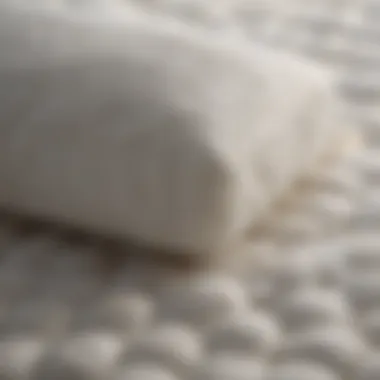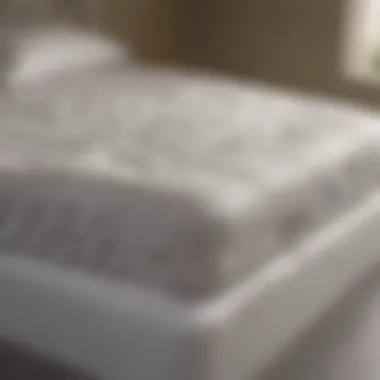Utilizing Lysol Spray on Mattresses: A Comprehensive Guide


Intro
Maintaining a clean mattress is vital for both health and comfort. Many individuals turn to products like Lysol spray for its disinfecting properties. However, the question arises: is it safe and effective for cleaning mattresses? This guide aims to explore the considerations of using Lysol spray on mattresses, outlining its benefits, potential health concerns, and alternative cleaning methods. Understanding these aspects will help you make informed decisions about mattress hygiene.
Before diving into specifics, it is important to clarify what Lysol spray is and how it functions. This cleaning agent is designed primarily for hard surfaces but is often used on soft surfaces, including mattresses, to eradicate germs and odors. The guide will address the effectiveness of Lysol spray and will highlight essential safety precautions to consider when using it on mattresses.
Understanding Mattress Hygiene
Maintaining mattress hygiene is crucial for overall health and well-being. Mattresses act as breeding grounds for various contaminants over time, which can affect sleep quality and even lead to health issues. Regular maintenance ensures that your sleeping environment remains clean and conducive to restful sleep. This guide delves into the elements that underscore the importance of mattress hygiene, its benefits, and some considerations that one should keep in mind.
The Importance of Mattress Maintenance
Proper maintenance of a mattress extends its lifespan and contributes to better sleep hygiene. Dust mites, bacteria, mold, and allergens accumulate in beds, making regular cleaning essential. Neglecting these issues can lead to respiratory problems, skin irritations, and diminished sleep quality.
- Improved Sleep Quality: A clean mattress helps in achieving uninterrupted sleep by reducing allergens.
- Longevity of Mattress: Regular care can help maintain the mattress' structural integrity, delaying the need for replacements.
- Health Benefits: Keeping your mattress clean reduces the risk of allergic reactions and respiratory diseases.
For optimal results, consider incorporating cleaning methods such as vacuuming, spot cleaning stains, and using disinfectants like Lysol spray, which can eliminate some pathogens.
Common Mattress Contaminants
Understanding what contaminants lurk within a mattress is key to addressing hygiene effectively. Common mattress contaminants include:
- Dust Mites: Microscopic creatures that feed on dead skin cells. Their droppings are a major allergen.
- Bacteria: Various bacteria can thrive in damp environments, often contributing to odors and skin irritations.
- Mold and Mildew: These fungi can develop in humid conditions, potentially leading to respiratory issues.
- Allergens from Pets: Pet dander can infiltrate fabrics, causing allergic reactions for sensitive individuals.
"Understanding common contaminants can equip homeowners with the knowledge needed to combat them effectively."
A clear awareness of these contaminants highlights the necessity for using products like Lysol, aiding in the battle against unseen threats while promoting a healthy sleep environment.
Lysol Spray: An Overview
Understanding Lysol spray is essential for anyone seeking to maintain a clean and healthy mattress environment. This cleaning agent is designed not just for surface sanitation, but also for eliminating specific microorganisms and dust mites that can settle into the fibers of mattresses. Knowing its multifaceted benefits and possible drawbacks allows for a responsible approach to its usage.
Chemical Composition of Lysol
Lysol products contain several active ingredients that contribute to their disinfectant properties. The core components of Lysol spray typically include alkyl dimethyl benzyl ammonium chlorides, also known as quaternary ammonium compounds. These chemicals are effective at breaking down cell walls of bacteria and viruses, facilitating an efficient disinfection process. Other ingredients might encompass isopropanol and ethanol, which serve as solvents to enhance disinfecting capabilities.
Besides these active ingredients, Lysol contains other substances that ensure the product's stability and performance. Fragrance chemicals are often added, giving Lysol its distinctive scent, which some users find comforting. However, it should be noted that fragrances may cause allergic reactions in some individuals. Therefore, understanding the composition is critical for individuals concerned about allergies or sensitivities.
Intended Uses of Lysol Spray
Lysol spray is designed for various cleaning purposes, making it a versatile tool in household maintenance. Primarily, it is intended for sanitizing surfaces in areas such as kitchens and bathrooms. However, its application can extend to furniture and other soft surfaces, including mattresses.
One of the notable uses of Lysol spray is its effectiveness against cold and flu viruses, as well as common allergens such as dust mites and mold spores.
Some key advantages include:
- Disinfecting capabilities: Effectively kills germs and viruses, making it suitable for infection control.
- Odor elimination: The formula helps to neutralize unpleasant smells, which can be especially beneficial for long-used mattresses.
- Convenience: The spray format allows for easy application, reaching into crevices and corners where allergens can hide.
"Lysol is employed not only for its disinfectant qualities but also for enhancing overall cleanliness and comfort within the home."


Usage instructions indicate that Lysol should be sprayed evenly on the mattress and allowed to dry properly before using the bedding again. However, caution is advised. Potential risks associated with application include irritation to respiratory systems and harm to certain fabric types if not tested beforehand.
In summary, the importance of understanding Lysol spray stems from its role in maintaining cleanliness and hygiene, especially regarding mattresses. Familiarity with its chemical composition and intended uses allows for informed and safe practices in mattress care.
Can You Use Lysol Spray on Mattresses?
When discussing mattress hygiene, the question of using Lysol spray arises frequently. The main elements to consider are the efficacy of the spray against germs and allergens, as well as the potential risks associated with its application. Understanding these aspects helps in making informed choices about mattress care. For anyone concerned about cleanliness and health, this topic warrants careful consideration.
Efficacy Against Germs and Allergens
Lysol spray is known for its disinfectant properties. It contains various active ingredients that target bacteria and viruses effectively. Research indicates that Lysol can reduce the number of germs present on surfaces, which can be a notable benefit when applied to mattresses. This ability to mitigate microbial presence is particularly advantageous for people with allergies or respiratory issues. Moreover, studies have shown that disinfectants like Lysol can reduce dust mites on bedding. This is essential as dust mites are a common allergen that can disrupt sleep and impact overall health.
- Lysol has been proven to eliminate:
- Bacteria such as Escherichia coli
- Viruses including Influenza
- Mold and mildew spores
While Lysol sprays effectively combat these pathogens, it is critical to follow the manufacturer's instructions. Applying the product correctly ensures maximum effectiveness in killing germs while maintaining safety for the user.
Potential Risks of Application
While Lysol can be beneficial for mattress hygiene, there are risks associated with its use. First, the chemicals in Lysol can produce strong odors and irritate the lungs, particularly in sensitive individuals such as children or those with pre-existing respiratory issues. Prolonged exposure may lead to adverse reactions. Therefore, proper ventilation during and after application is essential.
Additionally, not all mattress materials may react favorably to Lysol. Some fabrics might discolor or deteriorate when exposed to harsh chemicals, which could compromise the integrity of the mattress. Always check the mattress care label to ensure compatibility with cleaning agents.
"Using household disinfectants can enhance hygiene, but one must exercise caution to avoid potential harm to health and materials."
In summary, while Lysol spray can be effective in cleaning and disinfecting mattresses, understanding the right application and associated risks enables users to maintain a healthier sleep environment.
Step-by-Step Guide to Using Lysol on Mattresses
The significance of this section lies in its practical approach to employing Lysol spray to maintain a clean mattress environment. Mattresses can harbor bacteria, dust mites, and allergens over time. Utilizing Lysol effectively can help mitigate these issues, ensuring a healthier sleep surface. By following a structured guide, you can maximize the disinfectant’s benefits, while carefully considering its application to retain the integrity of your mattress.
Preparation Before Application
Before applying Lysol spray, it is essential to prepare your mattress and workspace properly. Start by removing all bedding from the mattress. This includes sheets, pillowcases, and mattress protectors. It is advisable to wash these items in hot water. This step helps eliminate dust mites and allergens that may have gathered in your bedding.
Next, choose a well-ventilated area for the cleaning process. Open windows or use fans to ensure sufficient airflow. In addition, gather necessary materials: Lysol spray, clean cloths or rags, and possibly gloves to protect your hands. Ensure that you read the instructions on the Lysol can to familiarize yourself with the specific application process, as formulations may differ.
How to Apply Lysol Spray Effectively
Once you have prepared your mattress and workspace, you can proceed to apply Lysol spray. First, shake the canister well, allowing the contents to mix fully. Hold the spray can about six to eight inches away from the surface of the mattress. This distance allows for even application while preventing excess liquid from pooling.
Begin by spraying a light and even coat across the entire surface of the mattress. Pay special attention to seams and crevices where dust mites and allergens are likely to accumulate. Avoid saturating the mattress, as this may lead to mold growth or damage the materials.
Allow the spray to sit for the recommended time as stated in the instructions. This duration is crucial, as it allows the cleaner to work effectively against germs and contaminants.
Drying and Finishing Touches
After the application period, it is time to ensure the mattress dries properly. Fans or a dehumidifier can assist in speeding up the drying process. Placing the mattress in a well-ventilated area will also help. It is important to let the mattress dry completely before putting any bedding back on it to prevent moisture build-up.


When the mattress is fully dry, inspect it for any remaining stains or spots that may need additional cleaning. Once satisfied, you may choose to apply a protective layer, such as a mattress cover, before returning your cleaned bedding to the mattress. This additional step can help maintain cleanliness longer and adds a layer of protection from future spills or accidents.
Properly utilizing Lysol spray to clean your mattress not only promotes hygiene but can also extend the lifespan of your sleeping surface.
Alternatives to Lysol Spray
Exploring alternatives to Lysol spray is essential for those seeking effective mattress cleaning without potential negative implications. While Lysol is a well-known disinfectant, other options exist that may better suit individual preferences and needs. By understanding these alternatives, consumers can make informed decisions about mattress hygiene.
Natural Cleaning Solutions
Natural cleaning solutions offer a gentler yet effective approach to disinfecting mattresses. These alternatives typically use ingredients found at home, avoiding harsh chemicals. Common natural solutions include:
- Vinegar: White vinegar is known for its antibacterial properties. It can be diluted with water and sprayed onto the mattress, helping to eliminate odors and kill bacteria.
- Baking Soda: A simple yet powerful cleaning agent, baking soda conducts moisture absorption and odor elimination. Sprinkling it on the mattress allows it to sit for several hours before vacuuming can help refresh the surface.
- Essential Oils: Oils such as tea tree or lavender not only provide pleasant fragrances but also possess antimicrobial qualities. Adding a few drops to vinegar or water can enhance the cleaning effect.
Using these natural solutions reduces chemical exposure, making them suitable for homes with children or pets. However, be sure to perform a patch test on any mattress material to avoid discoloration or damage.
Other Commercial Cleaning Products
Aside from Lysol, there are various commercial products specifically designed for mattress cleaning. These products are formulated to tackle common mattress contaminants, including dust mites and allergens. Some noteworthy options include:
- CleanSleep Mattress Cleaner: This product is designed to penetrate deeper layers and eliminate dust mites, odors, and stains without harsh chemicals.
- Mister Max Anti-Icky-Poo Odor Remover: This enzyme-based cleaner is effective against various organic stains and odors, making it suitable for pet owners.
- Zorb-It Mattress Cleaner: A foam cleaner that not only disinfects but also leaves a fresh scent, suited for various types of mattresses.
When choosing a commercial product, read the label carefully. Ensure it is safe for the specific mattress material to avoid any damage.
By considering these alternatives, individuals can tailor their mattress care approach to align with their values and health priorities.
Addressing Common Concerns
Addressing common concerns is crucial when discussing the use of Lysol spray on mattresses. Many people have reservations about the safety and efficacy of such cleaning practices. Being informed is imperative. This segment will delve into two primary areas of concern: safety for children and pets, and the potential impact on mattress materials.
Safety for Children and Pets
When it comes to cleaning products, understanding their safety is essential, especially if children and pets are present in the household. Lysol spray contains phenolic compounds and other chemicals that can pose risks if not used correctly.
- Restricting Access: Always ensure that your mattress is kept out of reach during the application process. This precaution prevents accidental exposure to the spray.
- Ventilation is Key: Ensure proper ventilation in the room while using Lysol. Open windows and turn on fans to help disperse any strong chemical odors. This step reduces the risk of inhalation, keeping your family safe.
- Drying Time matters: After applying Lysol, allow sufficient time for the mattress to dry completely. This process diminishes the chance of any residue remaining on the surface, which could be harmful when touched or inhaled by children or pets.
It is advisable to follow the instructions on the Lysol label closely and consider waiting a while before letting your children or pets back onto the mattress.
Impact on Mattress Materials
Understanding how Lysol spray interacts with various mattress materials is important for maintaining the integrity and longevity of your bed. Not all materials respond to disinfectants in the same way.
- Memory Foam: Using Lysol on memory foam can be tricky. It is porous and may absorb chemicals, which could lead to odor retention and a compromised structure.
- Latex Mattresses: Generally, latex is more resistant to harsh chemicals. However, it is still advisable to use Lysol sparingly, as frequent exposure may degrade the material over time.
- Fabric Covers: Upholstered mattresses may show discoloration or damage if Lysol is used excessively. Spot testing an inconspicuous area is wise.
Always consult the care instructions specific to your mattress type before applying any cleaning agent.
In summary, though Lysol can be an effective cleaning solution, attention must be paid to its application, ensuring safety for all household members and preserving the materials of your mattress.
Best Practices for Mattress Care


Maintaining your mattress is essential for both hygiene and longevity. Regular care not only contributes to a healthier sleep environment but also helps preserve your investment. A well-cared-for mattress can enhance comfort, improve sleep quality, and extend its lifespan. In this section, we will discuss key elements that constitute best practices for mattress care, focusing on the significance and benefits of a systematic approach.
Regular Cleaning Schedule
Establishing a routine to clean your mattress can prevent the accumulation of dust mites, allergens, and other contaminants. A regular cleaning schedule is crucial. It is advisable to vacuum your mattress at least once a month, ensuring that any debris or dust is removed. When vacuuming, make sure to use an attachment designed for upholstery to avoid damaging the fabric.
Additionally, consider spot cleaning stains with a mild solution of soap and water. For deeper cleaning, using a disinfectant spray like Lysol can be helpful, provided you follow the guidelines discussed earlier in this article.
- Vacuum Monthly: Remove dirt and dust.
- Spot Clean Stains: Act quickly to prevent permanent marks.
- Rotate Mattress: Every three to six months to ensure even wear.
- Air It Out: Place your mattress in a well-ventilated area, allowing fresh air to circulate.
"Regular care not only boosts your mattress's hygiene but also prolongs its usability."
Choosing the Right Mattress Protector
A quality mattress protector is a crucial investment for maintaining mattress hygiene. It serves as the first line of defense against spills, stains, and allergens. When selecting a mattress protector, consider one that is waterproof, breathable, and hypoallergenic. This choice will not only preserve the condition of your mattress but will also make it easier to clean.
Key features to look for include:
- Waterproof Barrier: Protects against spills and urine, extending the mattress’s life.
- Allergy Protection: Features that repel dust mites and other allergens can improve sleep quality.
- Breathable Materials: Ensure comfort and prevent overheating during sleep.
- Easy to Clean: Opt for materials that can be machine washed.
By investing in a suitable mattress protector and adhering to a regular cleaning schedule, you significantly improve the hygiene and durability of your mattress.
Scientific Perspectives on Disinfectants
Understanding the scientific perspectives on disinfectants is essential in evaluating their effectiveness and safety. This knowledge aids in making informed decisions about the products we use in our homes. Lysol spray is often employed for cleaning, especially on mattresses, due to its antibacterial properties. Evaluating disinfectants’ modes of action and their efficacy against various pathogens helps understand the broader implications of their use.
Disinfectants play a significant role in maintaining a healthy living environment. They help reduce the risk of infections and contribute to overall hygiene. However, users must consider various factors such as the specific pathogens targeted, surface compatibility, and any potential health risks associated with their application. Understanding these factors can guide effective cleaning practices while minimizing harm to health and materials.
Research on Alcohol-based vs. Lysol Disinfectants
Research indicates that alcohol-based disinfectants and Lysol spray achieve disinfection through different mechanisms. Alcohol-based disinfectants, such as those containing isopropyl or ethanol, disrupt the cell membranes of bacteria and viruses. This action leads to cell lysis and the inactivation of pathogens. Alcohol-based solutions are effective against many germs in short contact times. However, they may not be effective against all types of pathogens, especially non-enveloped viruses.
On the other hand, Lysol contains quaternary ammonium compounds (quats) and phenolic compounds. These ingredients have a broader spectrum of activity and can kill a wider variety of microorganisms, including bacteria, viruses, and fungi. The research shows that while alcohol may suffice for general use, Lysol may be a preferable choice for higher antimicrobial effectiveness on surfaces like mattresses. Consideration of these facts is paramount when selecting a disinfectant for specific cleaning needs.
Understanding the Role of Disinfectants in Health
Disinfectants serve as critical tools in reducing the transmission of diseases. Their role in health encompasses various dimensions, including the prevention of infections and the promotion of a cleaner living environment. By effectively reducing microbial load on surfaces, disinfectants minimize exposure to harmful pathogens that can lead to health complications.
However, the use of disinfectants must be balanced with a consideration of potential risks. Some individuals may experience allergic reactions or respiratory issues from inhaling disinfectant vapors. Moreover, improper use, such as failing to allow sufficient dwell time, can diminish their efficacy. This understanding emphasizes the importance of following manufacturer instructions and implementing good ventilation when using products like Lysol.
"The choice of disinfectant should be guided by specific needs and an understanding of the underlying science, ensuring both effectiveness and safety."
In summary, the scientific perspectives on disinfectants underscore their integral role in health while highlighting the necessity for responsible use. By exploring the differences between products like alcohol-based solutions and Lysol, individuals can make informed cleaning decisions that enhance hygiene without compromising well-being. This comprehensive approach promotes overall health and safety in settings where maintaining cleanliness is paramount.
End and Recommendations
Understanding how to utilize Lysol spray on mattresses is crucial for maintaining both hygiene and longevity of your bedding. Proper mattress care not only promotes better sleep but also contributes to overall health. The content reviewed in this article emphasizes that cleanliness directly affects well-being. Knowing how to disinfect effectively using products like Lysol can make a significant difference in your sleep environment.
Key Takeaways
- Efficacy: Lysol spray can be effective in eliminating common allergens and germs found on mattresses.
- Safety: It is essential to consider potential risks, especially concerning exposure for children and pets. Always ensure proper ventilation.
- Best Practices: Regular maintenance and proper techniques can maximize the benefits of disinfection.
The discussion around mattress hygiene does not simply stop at the application of Lysol. It requires an understanding of one's own living environment and personal needs.
When to Seek Professional Cleaning
There are instances when professional cleaning may be the better choice. If your mattress has significant stains, deep odors, or visible mold, hiring professionals might be necessary. They have access to specialized equipment and cleaning agents that can ensure thorough cleaning without damage.







